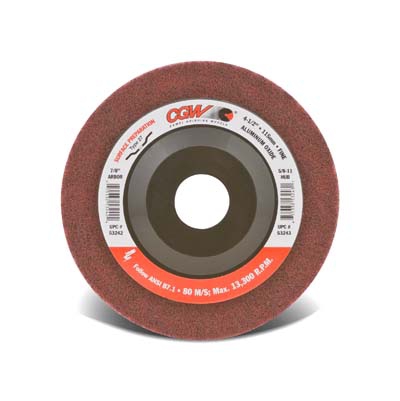
CGW-Camel Grinding Wheels expanded its surface conditioning offerings, adding a line of surface preparation aluminum oxide and silicon carbide wheels and discs.
The surface conditioning line is specially designed for blending, smoothing and finishing stainless steel, steel, aluminum and nonferrous metals.
Made from nonwoven material impregnated with abrasive grains, CGW's new surface preparation products remove paint, rust, and welding and cutting discoloration from stainless steel. The maroon-colored aluminum oxide products have a fine grit size, making them ideal for cleaning, blending and finishing stainless steel. The gray-colored silicon carbide products are very fine in grit size, and provide light finishes on metal, wood, composites and satin-finish aluminum.
The new type 27 shape surface preparation wheels are available in aluminum oxide and silicon carbide grains with 4-, 4 ½-, and 7-inch diameters. The type 27 wheels are designed with reduced backing to minimize work piece scratches and allow for full use of the wheel material.
The surface preparation discs have a roll-on attachment and are available in 2- and 3-inch diameters in aluminum oxide and silicon carbide grains.
"The new aluminum oxide and silicon carbide surface preparation wheels and discs allow CGW to offer a fuller line of quality abrasives," said Joe O'Mera, president, CGW-Camel Grinding Wheels.
Contact Details
Related Glossary Terms
- abrasive
abrasive
Substance used for grinding, honing, lapping, superfinishing and polishing. Examples include garnet, emery, corundum, silicon carbide, cubic boron nitride and diamond in various grit sizes.
- aluminum oxide
aluminum oxide
Aluminum oxide, also known as corundum, is used in grinding wheels. The chemical formula is Al2O3. Aluminum oxide is the base for ceramics, which are used in cutting tools for high-speed machining with light chip removal. Aluminum oxide is widely used as coating material applied to carbide substrates by chemical vapor deposition. Coated carbide inserts with Al2O3 layers withstand high cutting speeds, as well as abrasive and crater wear.
- backing
backing
1. Flexible portion of a bandsaw blade. 2. Support material behind the cutting edge of a tool. 3. Base material for coated abrasives.
- composites
composites
Materials composed of different elements, with one element normally embedded in another, held together by a compatible binder.
- grinding
grinding
Machining operation in which material is removed from the workpiece by a powered abrasive wheel, stone, belt, paste, sheet, compound, slurry, etc. Takes various forms: surface grinding (creates flat and/or squared surfaces); cylindrical grinding (for external cylindrical and tapered shapes, fillets, undercuts, etc.); centerless grinding; chamfering; thread and form grinding; tool and cutter grinding; offhand grinding; lapping and polishing (grinding with extremely fine grits to create ultrasmooth surfaces); honing; and disc grinding.
- grit size
grit size
Specified size of the abrasive particles in grinding wheels and other abrasive tools. Determines metal-removal capability and quality of finish.







